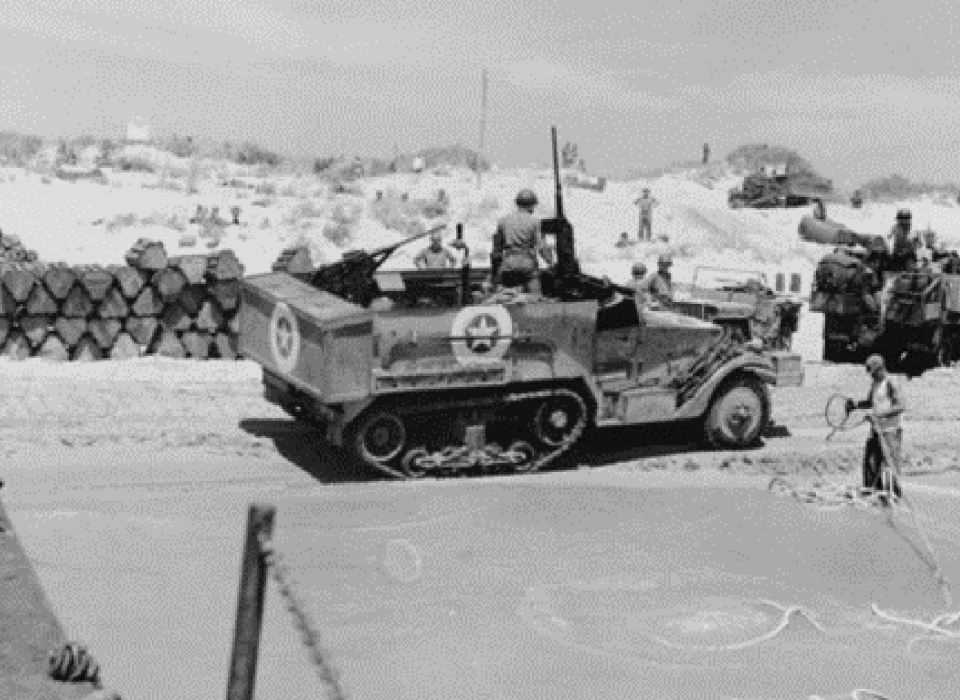This year marks the 80th anniversary of the Allied invasion of Sicily. The assault on this strategically important island not only advanced the Allied effort but served as classroom of sorts for American forces engaged in combat operations. Many of the tactics, techniques, and procedures used during the invasion—code-named Operation Husky—set a precedent for further development in amphibious assaults in the European theater of operations. In 1943, many American leaders were eager to initiate the cross-channel invasion and engage German forces on the continent of Europe. While certainly the most expeditious and shortest route to Berlin, neither the British nor the Americans were prepared for such a huge undertaking. A premature or failed assault in the English Channel might be an irreparable mistake.
In anticipation of the defeat of the German Afrika Korps, Allied leaders met in January 1943 at Casablanca to plan their next steps against the Axis. At this meeting, British strategists advocated a continuation of their Mediterranean campaign by invading Sicily and holding this important strategic location. By seizing the ancient island, the Allies would open the Mediterranean Sea line of communication while possibly forcing the capitulation of the Mussolini government. With a paucity of strategic shipping and manpower for the cross-channel assault, an invasion of the Axis “soft underbelly” became the next logical step.
Initiated on July 10, 1943, a combined US and UK force landed on the triangle-shaped island’s southern shores. Field Marshal Bernard Montgomery’s British Eighth Army was to lead the charge up Sicily’s eastern coastline while Lieutenant General George Patton’s Seventh US Army landed to the west and protected the British Army’s advance. Playing a secondary role to the British main effort, US forces landed at three designated locations code-named JOSS, CENT, and DIME, and soon encountered Italian and German forces on the established beachheads. A combined land and sea effort defeated German panzer attacks at the DIME location that threatened to push the US 1st Infantry Division into the sea. Simultaneously, the German Luftwaffe and Italian Regia Aeronautica aircraft made several attacks on the Allied fleet and the landing forces ashore. Despite these Axis efforts, the Allies successfully established a lodgment and began moving inland.
Perhaps most important for the amphibious effort was the use of new ship-to-shore platforms that allowed the American forces to develop a “logistics-over-the-shore” capability. With the introduction of the Landing Ship, Tank (LST), Landing Craft, Tank (LCT), and the Landing Craft Infantry (LCI), the combined Army-Navy team moved men and equipment ashore without need of a fixed port. While an established facility would certainly expedite offload and movement of materials and manpower, these vessels allowed corps and division formations to operate more readily in an austere and expeditionary environment. While the LST was used in the Torch invasion of North Africa, it was during Husky that the US-made vessels were employed in significant numbers. So important was this new platform that the number of LSTs available often drove Allied strategic planning in the European theater. In fact, the value of these ships led British Prime Minister Winston Churchill to quip: “The destinies of two great empires seemed to be tied up in some god-dammed things called LSTs.”
Patton’s Seventh US Army worked closely with Admiral Kent Hewitt’s Western Naval Task Force (WNTF) to coordinate naval guns, Army artillery, and armor ashore. On D+1, a German armor column composed of Panzer MK IV and MK VI tanks threatened the American landings at Gela, driving within 1,000 yards of the beach. WNTF ships offshore along with newly arrived armor and artillery repulsed the Hermann Göring Panzer Division’s counterattack. As naval guns hit enemy armor on the Gela plain, 16 German tanks became smoking hulks. Combined with Army ground fire, the joint effort destroyed an estimated one-third of the of the Hermann Göring Division’s armor in a single engagement. The synergy of combined arms saved the day and illustrated the power of coordinated joint fires.
Helping the development of combined arms, the US Army Air Forces also contributed by shaping the battlefield before the Allied landings. German airfields, rail lines, ports, and roads were attacked in an attempt to isolate the battlefield. Conducting battlefield air interdiction (BAI), the USAAF frustrated German movement on the island while trying to cut it off from the Italian mainland. In addition, Air Forces assets were used in the development of close air support (CAS) missions to assist ground forces engaged with the enemy. While these methods had yet to be perfected, it was part of the evolution of US air-ground coordination on the battlefield. These methods would be further refined and developed during the next few amphibious assaults and later became a key element in Allied ground offensives.
For the British Eighth Army, the movement up the Sicilian coast was a slow and painful slog. With the city of Messina on the northeastern tip of the island as the campaign’s ultimate objective, Patton decided to take matters into his own hands and burnish the American soldiers', and his own, fighting reputation. Meeting with Sir Harold Alexander, the Husky Ground Force Commander, Patton received approval on July 17 to push Major General Lucian Truscott’s 3rd Infantry Division and Major General Geoffrey Keyes’s 2nd Armored Division to both the northern and western parts of the island. With this modification, the two commanders captured the port city of Palermo on July 22. Clearing the harbor of debris and wreckage, the facility served as an important logistics hub as Patton moved other elements of his Seventh Army east toward Messina along the island’s northern half. As British forces moved up the eastern coast, the American 1st, 3rd, and 45th Infantry Divisions moved across the island, capturing the towns of Enna and Troina. Conducting controversial amphibious assaults at Brolo and Milazzo on the north coast, the Seventh Army eventually met stiff German resistance at the foot of the Mount Etna volcano.
In the first weeks of August, American forces began penetrating the German defenses along the Etna Line and pushed farther toward Messina. Montgomery’s Eighth Army made slow but steady progress moving north, capturing the city of Catania, and encountered German forces on the eastern end of the Etna Line. With Allied forces making good progress, the German forces, consisting of the 15th and 29th Panzer Grenadier Divisions, the Hermann Göring Division, and the 1st Parachute Division, began evacuating the island on August 11. Conducting a phased withdrawal from their defensive positions, German formations embarked on “Siebel ferries” at the port of Messina, making their way across the strait to the town of Calabria and avoiding complete destruction. Almost 40,000 troops, 14,000 casualties, 10,000 vehicles, 51 tanks, and 163 artillery pieces were evacuated over a two-week period. Many of these units and their equipment would be reconstituted on the Italian peninsula and engage Allied forces in the later amphibious assaults of Avalanche and Shingle.
At 0800 on August 17, Seventh Army elements arrived in Messina with an Italian army representative, offering to surrender the city to General Truscott. Out of respect for his superior, and following Patton’s order that no one was to arrive in the town until after the Seventh Army commander, Truscott waited two hours for Patton to arrive and accept the Italian offer. Afterward, Patton took a victory parade through Messina and greeted British officers who soon arrived in the city. After a hard-fought 48 days, the Allies were victorious, the American fighting reputation was firmly established, all the campaign objectives were met, and the Mussolini government had fallen.
Operation Husky was more than just the liberation of the Sicilian Island and an impetus for the fall of Mussolini. With only Operation Torch and the North African Campaign under their belts, Husky provided much needed practical experience for the US Armed Forces. The lessons garnered from the operation were important for the refinement and development of amphibious operations and other methodologies for fighting German forces. As a precursor to the cross-channel Normandy invasion, the Sicilian campaign yielded new and important lessons on air-ground coordination, Army-Navy cooperation, tactical methods, and the generation of combat power ashore. The Allied success at Normandy on June 6, 1944, could not have come about without Husky and its many lessons.
In July 2023, in the Sicilian city of Catania, Museum representatives participated in the Peace, Security, and Prosperity Conference that included discussions on the American participation in the campaign. This international gathering also addressed potential ways of commemorating the 1943 Allied effort. While the British Commonwealth and Germans have cemeteries and monuments on the island, currently there are no official US monuments. The only testament to US forces on the island is a makeshift one that memorializes the operations of the 82nd Airborne Division at Biazza Ridge. Museum representatives hope to correct this glaring historical omission. In addition to these discussions, attendees also participated in ceremonies at the Gela and Pachino Beaches, paying their respects to the British, Canadian, and American troops that liberated the island and helped begin the assault on the European mainland.
John Curatola, PhD
John Curatola, PhD, is the Samuel Zemurray Stone Senior Historian at the Jenny Craig Institute for the Study of War and Democracy.
Cite this article:
MLA Citation:
APA Citation:
Chicago Style Citation:







![Max Fuchs, New York City cantor, sings as Rabbi Sydney [sic] Lefkowitz, Richmond, VA, conducts the first Jewish services from Germany.](/sites/default/files/styles/max_650x650/public/2025-10/image1.jpg)



